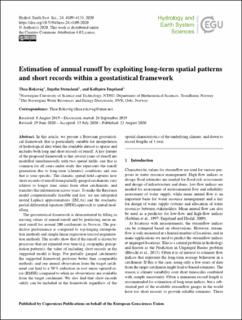| dc.contributor.author | Roksvåg, Thea | |
| dc.contributor.author | Steinsland, Ingelin | |
| dc.contributor.author | Engeland, Kolbjørn | |
| dc.date.accessioned | 2022-05-10T11:35:21Z | |
| dc.date.available | 2022-05-10T11:35:21Z | |
| dc.date.created | 2020-06-30T11:54:40Z | |
| dc.date.issued | 2020 | |
| dc.identifier.citation | Hydrology and Earth System Sciences. 2020, 24 4109-4133. | en_US |
| dc.identifier.issn | 1027-5606 | |
| dc.identifier.uri | https://hdl.handle.net/11250/2995056 | |
| dc.description.abstract | In this article, we present a Bayesian geostatistical framework that is particularly suitable for interpolation of hydrological data when the available dataset is sparse and includes both long and short records of runoff. A key feature of the proposed framework is that several years of runoff are modelled simultaneously with two spatial fields: one that is common for all years under study that represents the runoff generation due to long-term (climatic) conditions and one that is year-specific. The climatic spatial field captures how short records of runoff from partially gauged catchments vary relative to longer time series from other catchments, and transfers this information across years. To make the Bayesian model computationally feasible and fast, we use integrated nested Laplace approximations (INLAs) and the stochastic partial differential equation (SPDE) approach to spatial modelling.
The geostatistical framework is demonstrated by filling in missing values of annual runoff and by predicting mean annual runoff for around 200 catchments in Norway. The predictive performance is compared to top-kriging (interpolation method) and simple linear regression (record augmentation method). The results show that if the runoff is driven by processes that are repeated over time (e.g. orographic precipitation patterns), the value of including short records in the suggested model is large. For partially gauged catchments the suggested framework performs better than comparable methods, and one annual observation from the target catchment can lead to a 50 % reduction in root mean squared error (RMSE) compared to when no observations are available from the target catchment. We also find that short records safely can be included in the framework regardless of the spatial characteristics of the underlying climate, and down to record lengths of 1 year. | en_US |
| dc.language.iso | eng | en_US |
| dc.publisher | European Geosciences Union | en_US |
| dc.rights | Navngivelse 4.0 Internasjonal | * |
| dc.rights.uri | http://creativecommons.org/licenses/by/4.0/deed.no | * |
| dc.title | Estimation of annual runoff by exploiting long-term spatial patterns and short records within a geostatistical framework | en_US |
| dc.title.alternative | Estimation of annual runoff by exploiting long-term spatial patterns and short records within a geostatistical framework | en_US |
| dc.type | Peer reviewed | en_US |
| dc.type | Journal article | en_US |
| dc.description.version | publishedVersion | en_US |
| dc.source.pagenumber | 4109-4133 | en_US |
| dc.source.volume | 24 | en_US |
| dc.source.journal | Hydrology and Earth System Sciences | en_US |
| dc.identifier.doi | 10.5194/hess-24-4109-2020 | |
| dc.identifier.cristin | 1817789 | |
| dc.relation.project | Norges forskningsråd: 250362 | en_US |
| cristin.ispublished | true | |
| cristin.fulltext | original | |
| cristin.qualitycode | 2 | |

